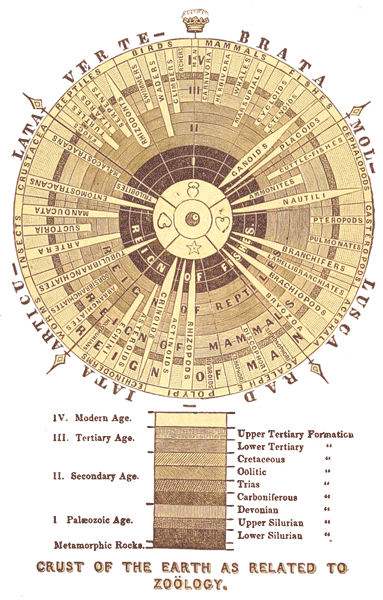COVER
PREFACE
5
005
006
007
> Embryology, Metamorphosis,
philosophical zoölogy,
Explanation of the Figures 11 011
012
013
014
015 016
INTRODUCTION 17 017
018
019 020
021
022
023
024
I. The Sphere and Fundamental Principles of Zoology 25 025
026
027 028
029
030
031
032
033
034
[033] Many [fossil] species present
forms so extraordinary that it is almost impossible to trace their
alliance with any animal now living. In general, they bear a
striking analogy to the embryonic forms of existing species. For
example, the curious fossils known under the name of Trilibites (Fig.
156) have a shape so singular that it might well be doubted to what
group of articulated animals they belong. But if we compare them with
the embryo crab, we find so remarkable a resemblance that we do not
hesitate to refer them to the crustaceans. We shall also see that some
of the Fishes of ancient epochs present shapes altogether peculiar to
themselves (Fig. 157) but resembling, in a striking manner, the
embryonic forms of our common fishes.
II. General Properties of Organized Bodies 35 035
036
037
038
039
040
041
042
043
1. Organized and Unorganized
Bodies 35.
2. Elementary Structure of Organized bodies 36
3. Differences between Animals and Plants 41
III. Functions and Organs of Animal Life 44 044
045
046
047
048
049
050
051
052
053
054
055
056
057
058
059
060
061
062
063
064
065
066
1. Of the Nervous System and General
Sensation 44
2. Of the Special Senses 48
Sight, Hearing, Smell, Taste, Touch,
the Voice.
IV. Of Intelligence and Instinct 67 067
068 069
070
071
072
V. Of Motion 73 073 074
075
076
077
078
079
080
081
082 083
084
085
086
087
088
089
090
091
092
093
094 095
1. Apparatus of Motion 73
2. Of Locomotion 79
VI. Of Nutrition 96 096
097
098
099
100
101
102
103
104
105
106
107
108
109
110
1. Of Digestion
97
VII. Of the Blood and Circulation
111 111
112
113
114
115 116
117
VIII. Of Respiration 118 118
119 120
121
122
123
124
125
IX. Of the Secretions 126 126
127 128
129
130
X. Embryology 131 131
132
133
134
135
136
137
138
139
140
141
142
143
144
145
146
147
148
149
150
151
152
153
154
155
1. Of the egg 131
2. Development of the Young within the Egg 139
3. Zoological Importance of Embryology 153
XI. Peculiar Modes of Reproduction 156 156
157
158
159
160
161
162
163
164
165
166
167
168 169
170
171
172
173
1. Gemmiparous and Fissiparous
Reproduction 156
2. Alternate and Equivocal Reproduction 158
3. Consequences of Alternate Generation 167
XII. Metamorphoses of Animals 174 174
175
176
177
178
179
180
181
182 183
184
185
XIII. Geographical Distribution of Animals 186 186
187
188
189
190
191
192
193
194 195
196
197
198
199
200
201
202
203
204
205
206
207
208
209
210
211
212
213
1. General Laws of Distribution
186
2. Distribution of the Faunas 194
3. Conclusions 207
XIV Geological Succession of Animals; Or, Their Distribution in
Time 214 214
215 216
217
218
219 220
221
222
223
224
225
226
227 228
229
230
231
232
233
234
235
236
1. Structure of the Earth's Crust
214
2. Ages of Nature 221
Palaeozoic Age 221, Secondary Age 223,
Tertiary Age 233, Modern Age 235,
[214] The records of the Bible, as well
as human tradition, teach us that man and the anials associated with
him were created by the word of God; "the Lord made heaven and earth,
the sea, and all that in them is;" and this truth is confirmed by the
revelations of science, which unequivocally indicate the direct
interventions of creative power.
>Plutonic or Igneous rocks, Neptunic, Sedimantary or Stratified
rocks,
CONCLUSIONS 237
237
238
239
INDEX and GLOSSARY
241
242
243
244
245
246
247
248
List of Most Important Authors
249
250




